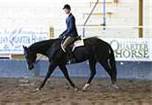Which Style of Riding Should You Choose?
Riders new to my facility are given the choice between English and Western riding. After some discussion most choose to start Western. A smaller number will choose English. An even smaller number will choose one style only to switch to the other. Does it make a difference? What is the difference between the styles? How do you choose? Here is some information to help you make your decision.
Western
Western style riding originated with the Vaqueros from Mexico. The American cowboy made necessary adaptations to the style and created what is now know as the western riding style. Western saddles 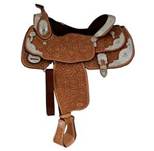 are large, heavy and have a deep, comfortable seat. The stirrups are attached to the saddle with wide, leather fenders that protect the riders leg from rubbing on the horse. These fenders lack mobility which helps keep the riders leg still. However; it also limits the riders ability to move their leg and puts leather between the rider and the horse which prevents easy cueing of the horse. Most western riders sit, rather than post, the trot which is easier to learn if the horse moves slow and smoothly. Western riders also sit the lope rather than riding standing in a half-seat. While this will take some practice, it can be easier to learn.
are large, heavy and have a deep, comfortable seat. The stirrups are attached to the saddle with wide, leather fenders that protect the riders leg from rubbing on the horse. These fenders lack mobility which helps keep the riders leg still. However; it also limits the riders ability to move their leg and puts leather between the rider and the horse which prevents easy cueing of the horse. Most western riders sit, rather than post, the trot which is easier to learn if the horse moves slow and smoothly. Western riders also sit the lope rather than riding standing in a half-seat. While this will take some practice, it can be easier to learn.
Western disciplines range from the fairly simple to the very complex. Western Pleasure is usually learned in the beginning and allows the rider to master the basics of moving their horse forward in the walk, jog, and lope. Backing-up is necessary to compete in this event along with an extended trot. More advanced forms of Western Riding include-
Barrel Racing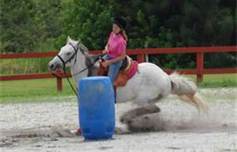 ,
,
Trail riding, 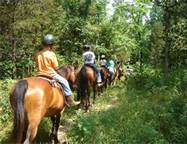
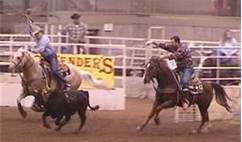
Roping,
Reining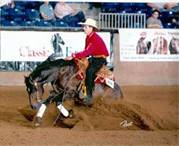
and Western Dressage. 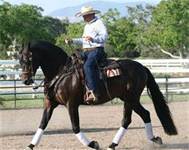
All these forms are best learned after you have a good grasp on the basics such as: Lengthen and shorten the stride of all gaits, recognition of leads and a good seat without stirrups.
English
It should come as no surprise to learn that English style riding came from England. The British nobility used horses for basic transportation and for sport, such as fox hunting. The Hunt Seat saddle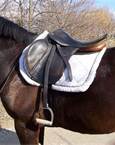 was designed to be lightweight and easy to move around in. The saddle has a shallow seat for ease of movement either forward or backwards, padded knee rolls for stability and loosely hanging stirrup irons for mounting and ease of leg movement. The riders wear knee-high, tall boots to protect their legs from rubbing against the stirrup leathers or horse. Due to the short stirrup length and the overall size of most English horses, most riders will post the trot i.e. moving forward (standing up) out of the saddle and back (sitting down) with the horses movement. Often the canter is ridden partially out of the saddle as well. This is called the “half-seat”, which is not to be confused with the “two-point” which is the very forward, out of the saddle position used while jumping. Because the rider is often not in contact with the saddle, English riding requires more athleticism and energy then Western Style .
was designed to be lightweight and easy to move around in. The saddle has a shallow seat for ease of movement either forward or backwards, padded knee rolls for stability and loosely hanging stirrup irons for mounting and ease of leg movement. The riders wear knee-high, tall boots to protect their legs from rubbing against the stirrup leathers or horse. Due to the short stirrup length and the overall size of most English horses, most riders will post the trot i.e. moving forward (standing up) out of the saddle and back (sitting down) with the horses movement. Often the canter is ridden partially out of the saddle as well. This is called the “half-seat”, which is not to be confused with the “two-point” which is the very forward, out of the saddle position used while jumping. Because the rider is often not in contact with the saddle, English riding requires more athleticism and energy then Western Style .
English disciplines range from the simple to the very complex also. English Pleasure is usually learned in the beginning and allows the rider to master the basics of moving their horse forward while steering in the walk, trot, and canter. Backing-up is necessary to compete in this event along with an extended trot. More advanced forms of English riding include-
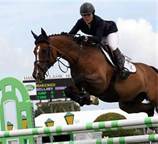 Hunters & Jumpers, Dressage,
Hunters & Jumpers, Dressage, 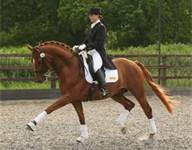
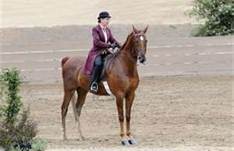 Saddle Seat
Saddle Seat
and Trail Riding.
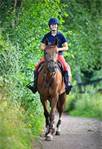
While Saddle Seat is considered an English Discipline, it is very different from Hunt Seat Style. Saddle Seat style originated in the U.S. and is often used while riding American born gaited horses such as the Saddlebred, Tennessee Walking Horse or the National Show Horse. The basic Saddle Seat Saddle is still English but the seat is very flat and shallow. The stirrups are longer than Hunt Seat style, but the rider will post the trot, if the horse does indeed trot. (Many gaited horses do not have a true trot.) The Saddle Seat saddle does not have padded knee rolls because these saddles are not designed for jumping. 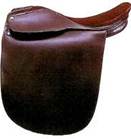
No matter what style of riding your choose you will need time, patience, and practice before you and your horse can perform together. Whether that performance is at a national show or just in your own backyard. And remember just because you choose one style, there is always more to learn in this grand adventure we call Equestrian Sports. Perhaps later you will choose to learn another style also. Enjoy The Ride!
Please feel free to share this article with your friends, but rights to publish it are reserved by the author. Tell us about your favorite riding style. We’d love to hear your stories!


